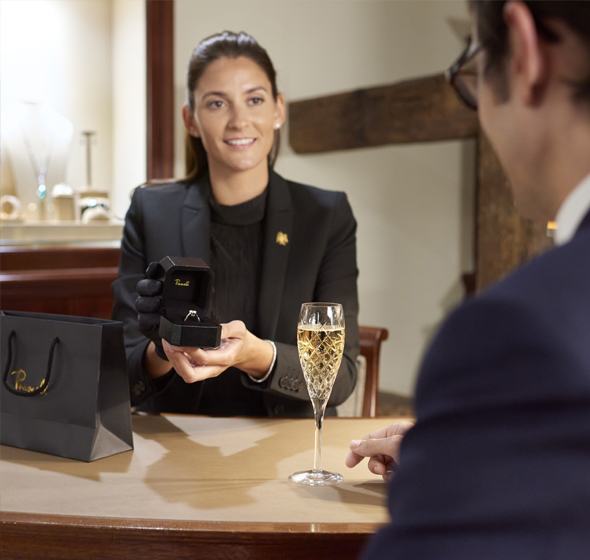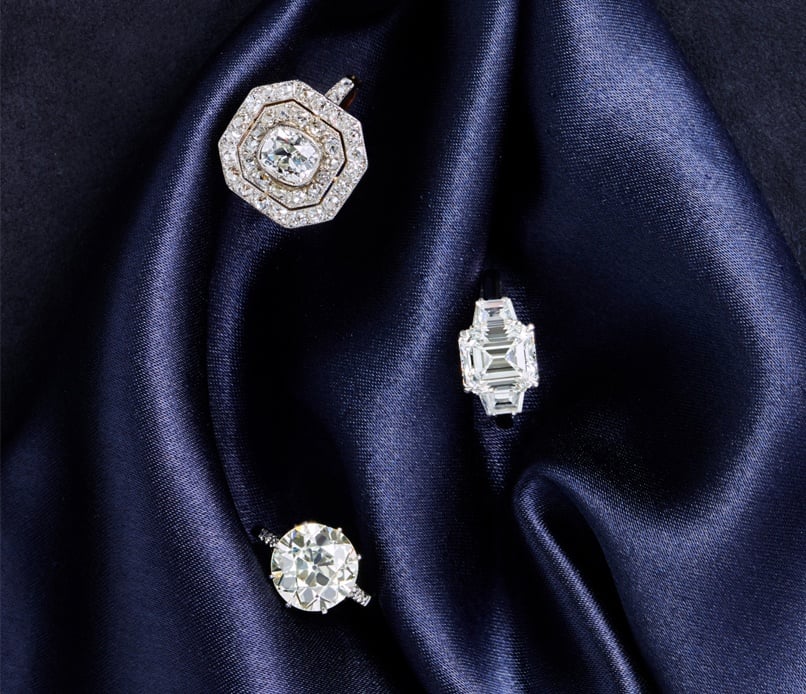Antique Diamond Cuts
At Pragnell, we are one of the few fine jewellers who use antique cuts in some of our jewellery designs. Pragnell antique diamonds are upcycled from once loved jewellery, and are arguably one of the “cleanest” diamond options available: there is no environmental impact whatsoever in their sourcing. Although these antique cuts have been used in jewellery for centuries, the demand for vintage diamond rings and historic diamonds is currently surging. As a truly sustainable diamond option, these stones have inspired many creations at Pragnell over the years.

Rose Cut Diamonds
In the late 1500s, Indian lapidaries - people who cut, polish or engrave gems - developed the Rose cut, so-called because it resembles a rosebud. Dome shaped, with a flat base and large, triangular facets on top, Rose cut diamonds were hewn from shallow Indian rough. The varying number of triangular facets are responsible for the Rose cut’s lustrous sparkle.
European cutting houses then perfected the style, and Rose cuts were subsequently used in jewellery throughout the 17th and 18th centuries.
We source all our Rose cuts from antique jewellery, giving a new lease of life to these romantic, historic and enduringly charming diamonds.

Old Mine Cut Diamonds
By the 18th century, Old Mine cut diamonds were introduced. They were cut and polished on a wheel powered by a foot pedal, and were shaped at the discretion of the individual stonecutter. Each of these antique diamonds has a history that is time-stamped into their shape by the available cutting technology of the period, and the unique skills of the individual stonecutters who left their mark on them.
Old Mine cuts were the precursor of the modern round brilliant and have a small table, large girdle, deep pavilion and high crown, as well as a distinctive large flat culet, which is visible when you look through the top of the stone.

Old European Cut Diamonds
Technological advancements in the late 1800s meant the Old Mine cut was refined into the Old European cut, which was rounder and more symmetrical, with more facets.
The Old European diamond has a steeper crown, a very small table, and great overall depth. This cut was then tweaked and perfected to create what would become the modern Round Brilliant cut.
Like the modern Round Brilliant cut, the Old European cut diamond has a circular girdle and an unforgettable sparkle.

Antique Cushion Cut Diamonds
The Antique Cushion cut is an evolution of the Old Mine cut; it is the antique version of today’s Modern Cushion cut. The Cushion cut was, and still is, one of the most popular diamond cuts.
The Cushion cut is a rectangular or square shape with rounded corners. Unlike the Old Mine cut, the Cushion Cut has no culet, a lower
crown and a shallowed pavilion – reducing the overall depth of the diamond. However, the table is larger, allowing the eye to look into, and travel around, the inside of the diamond.
While the higher crown of the Old Mine cut produces a beautifully shaped diamond, it reduces the carat weight, which these days outweighs other aspects of the diamond.

Asscher Cut Diamonds
The 1920s and 30s saw a surge in creativity in jewellery design, as well as in diamond cutting. During this period, Step cut stones were developed, with parallel facets which create a ‘hall of mirrors’ effect.
The Asscher cut was invented by the Royal Asscher Diamond Company in 1902, but was not used widely until the 1920s. Original Asscher cuts are square or rectangular, with large step facets, high crowns and small tables. The rectangular versions became known as Emerald cuts. Both possess the geometric elegance we associate with the Art Deco era and continue to be popular today.
Emerald and Asscher cut diamonds are still produced, but we believe that original Asscher cuts from the 1920s and 30s have a brightness and liveliness that is unrivalled by modern versions. We source and remount some of the most beautiful old Asscher cuts - perfect if you are looking for an Art Deco engagement ring.

French Cut Diamonds
The Art Deco period also saw the development of French cut diamonds, which are square with eight facets on top, resulting in a distinctive star effect when viewed from above.
The French cut is a progression from the first cut diamond in history, the Table cut. The very first cuts used another diamond to cleave along the natural planes: the Table cut had nine rudimentary facets. As the name suggests, the top of the Table cut diamond is flattened and resembles a square table. All four sides of the diamond have a bevel-like facet meeting at a pointed bottom.
Over the years, four more facets were added to the crown area of the diamond. This shape reflected more light, captivating attention and making it a very desirable cut. The term French cut was coined for its immense popularity in France.
The sophisticated simplicity of the French cut enables it to complement many other diamond cuts and shapes.


Make an Appointment
Our expert consultants are on hand to guide you through the process of choosing your eternity ring and answer any questions you may have, whether you book an appointment, or visit us to browse.
Visit one of our three jewellery showrooms and speak with one of our experts.
Alternatively, if you are unable to visit the showroom, you can book a virtual appointment. One of our experts will video call you to understand your requirements - you’ll receive our usual high standard of service, all from the comfort of your own home.
View by Category
Explore our diverse range of antique diamond pieces
You May Be Interested In
Antique CLP Page








